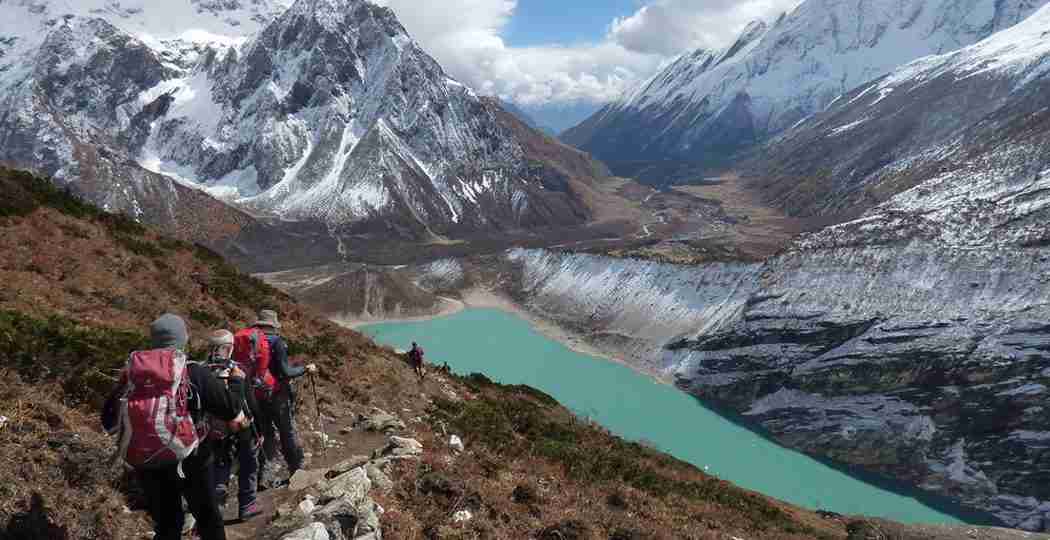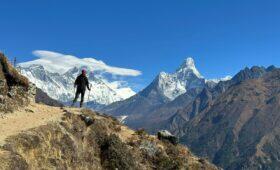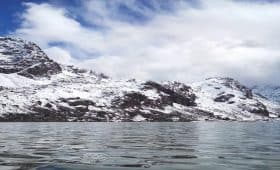Manaslu circuit trek is a popular trekking destination that encircles the Manaslu peak. The trek usually starts from Soti Khola and takes you to various hamlets around Manaslu. Sometimes the Manaslu circuit trek even stretches further to the Tibetan borders. It makes the Manaslu circuit trek a very interesting destination for trekking in nepal. The northern Tibetan borders and several places of the Manaslu circuit treks are unexplored. These “rare” and “unspoiled” places will make up for a great trekking experience.
Here are some facts about Manaslu circuit trek that will convince you to do this trek.
Table of Contents
- 1) Manaslu, the eighth tallest peak in the world.
- 2) Manaslu circuit trek trail lies within conserved areas.
- 3) Restriction on solo travels
- 4) The strenuous Larkey La Pass crossing
- 5) The geography of the Manaslu circuit trails
- 6) Overnight stay in tea houses
- 7) The Nubri and Tsumba settlements
- 8) The rich bio-diversity and rare wildlife
- 9) The climate of the Manaslu region
- 10) The ancient salt trading routes
1) Manaslu, the eighth tallest peak in the world.
The Manaslu circuit trek is fundamentally just a trek around the Manaslu massif. The mountain is famous as the eighth-highest peak on earth. The mountain is also the highest peak in the Gorkha district. It lies at a staggering height of 8,613 meters and is a popular mountaineering destination.
The peak was open for trekking and climbing very recently, in 1992 A.D. Climbers around the world aim to summit this peak. Manaslu is of the easiest peaks to summit among the many staggering peaks of Nepal. People consider Manaslu the easiest eight-thousand-meter peak to climb after mount Cho Yu.
The mountain lies in the west-central region of the Nepali Himalayan range. It is housed among ranges of other famous mountains of Nepali like Nagdi, Himalchuli, Boudha Himal, Annapurna range, etc.
2) Manaslu circuit trek trail lies within conserved areas.

The Manaslu circuit trek takes you to several protected areas in the Nepalese Himalayan foothills. You need to acquire permits to travel in these protected areas in your Manaslu circuit trek. There are essentially three permits you need for the Manaslu circuit trek. They are as follows:
- Special Restricted Area Permit of Manaslu – This permit costs you USD 100 per person per week during September, October, and November. For treks extending more than one week, you have to pay USD 15 per person per day. For the rest of the year, the permits will cost you USD 75 per person per week from December to August. The treks extending a week will need USD 10 per person per day.
- Manaslu Conservation Area Permit – You need this permit as you enter the Manaslu Conservation Area. It costs USD 30 per person all around the year.
- Annapurna Conservation Area Permit – You will also need the ACAP permit in your Manaslu circuit trek as you will be walking some part of Annapurna Circuit Trek. This permit will cost you USD 30 per person all around the year.
3) Restriction on solo travels
The Manaslu circuit’s trekking trails are a relatively new trekking destination. Due to the trails being so rare and remote, the new government does not allow people to travel the area solo. If you are planning for Manaslu Circuit Trek without guide and planning to go solo, it’s impossible. You need to travel with at least another trekker and hire a licensed guide. We highly recommend you trek the area under a reputable trekking agency. We at Mosaic Adventure will ensure your guides are legit and your permits are taken care of. Guides and proper help in remote trekking trails are a must. Sometimes unpleasant incidents could occur if you do not follow proper safety measures.
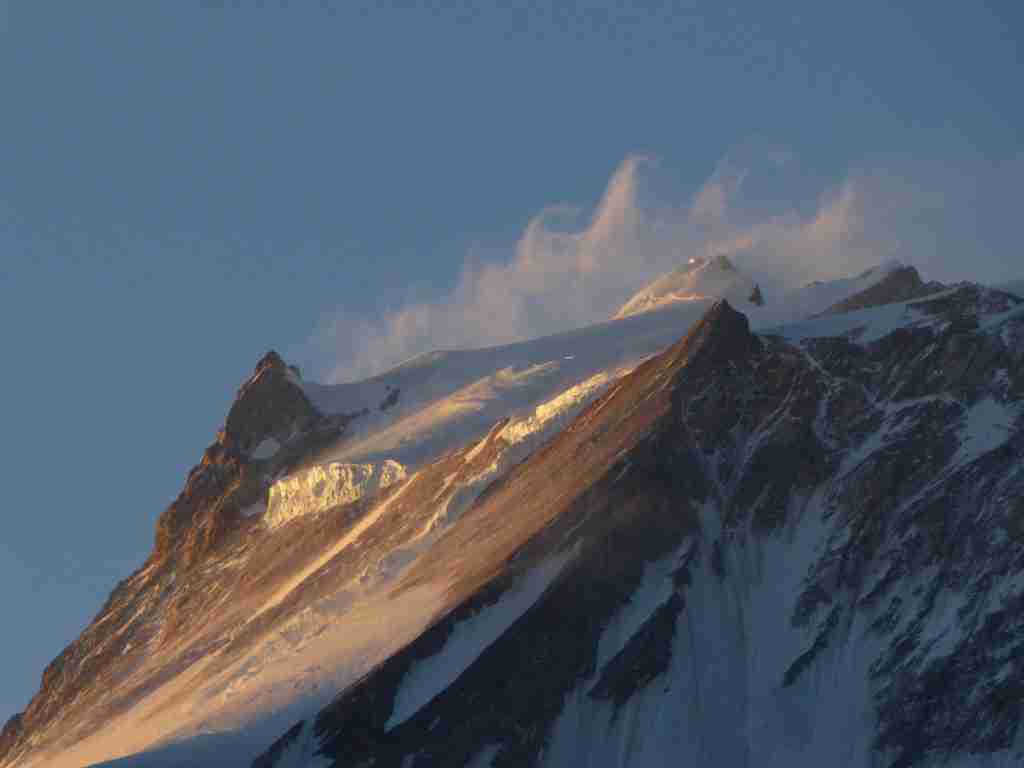
4) The strenuous Larkey La Pass crossing
Many variations of the Manaslu circuit trek include crossing the Larkey La Pass. The trek while crossing this pass is quite challenging. You need to walk around 4 to 6 hours for around a fortnight to complete this trek. A bonus to such a hectic trek is crossing the high-altitude trails of the Larkey La Pass, which lies at 5,106 meters.
The pass is the longest in Nepal and is very treacherous. Trekking along this pass requires technical descends, caution, and strength. So to venture for your Manaslu circuit trek, keep these points in mind. Get help from your fellow trekkers and guides on strenuous paths. Build enough stamina to keep you going for a long duration of walks. This way, your trekking throughout the Manaslu trails will be a success.
5) The geography of the Manaslu circuit trails

The Manaslu circuit trail covers a diverse range of geographical areas. The Manaslu Conservation Area covers the subtropical foothills of the Himalayas. Along with that, it also encompasses the Himalayas and Trans-Himalayan regions along the Tibet border.
From Arughat to the Larkya La Pass, this region is divided into six climate zones. We classify them as follows:
- The region lying between 1,000 meters and 2,000 meters is the tropical zone.
- The region lying between 2,000 meters and 3,000 meters is the temperate zone.
- The region lying between 3,000 meters and 4,000 meters is the subalpine zone.
- The region lying between 4,000 meters and 5,000 meters is the alpine zone
- The region lying above 4500 meters is the arctic region.
Along with diverse geography based on altitude, Manaslu also has diverse landforms. The Manaslu trail also shows glimpses of various mountains, glaciers, hills, and rivers. You can see beautiful mountains like Ngadi Chuli, Himalchuli, and Baudha. It has tons of routes for trekking as well as peaks for climbing. You can find trekking peaks like Larkey and expedition peaks like Manaslu in the region.
The hill range of Annapurna and Ganesh Himal is also visible from the Manaslu trail. Similarly, the Manaslu trail passes along the Budhi Gandaki and Marsyangdi rivers. The overall geography of the Manaslu circuit trek is remarkably diverse. Just reading about it piques your curiosity and entices you to observe the place.
6) Overnight stay in tea houses
One of the known facts about Manaslu circuit trek is its lodging provisions. If you have researched a little about treks in Nepali Himalayan foothills, you must be familiar with them. The lodging options on such treks are local tea houses. So is the case in the Manaslu circuit trekking trails. You will be staying in local tea houses that the people of the community run. These tea houses provide small rooms with shared beds and communal dining and toilets.
Tea houses also provide you with basic meals for the day. They serve the typical Nepali meals, including “Dal Bhat Tarkari” or rice, lentil, and vegetables. You can also get local Nepali snacks like Chowmein Noodles, Mo:Mo: etc.
The tea houses also give you somewhat luxurious facilities for an extra charge. They can give you hot bath water by heating water over firewood. You cannot get hot water from a tap, so you must pay extra for such a service. They also charge some money for Wifi if available, as Wifi is scarce in the region.
The resources available in tea houses are very pricey. Despite the expenses, the tea houses are very hospitable. The people you meet will be pretty friendly and homely. They will manage things for you to the best of your ability. All you have to do is not bargain with them and respect them. Most transactions in such tea houses are very reasonable. The locals need to transfer goods to high, remote, rugged trails. Hence, the price of amenities in the area is staggeringly high. People running the tea houses most definitely are not scamming you.
7) The Nubri and Tsumba settlements
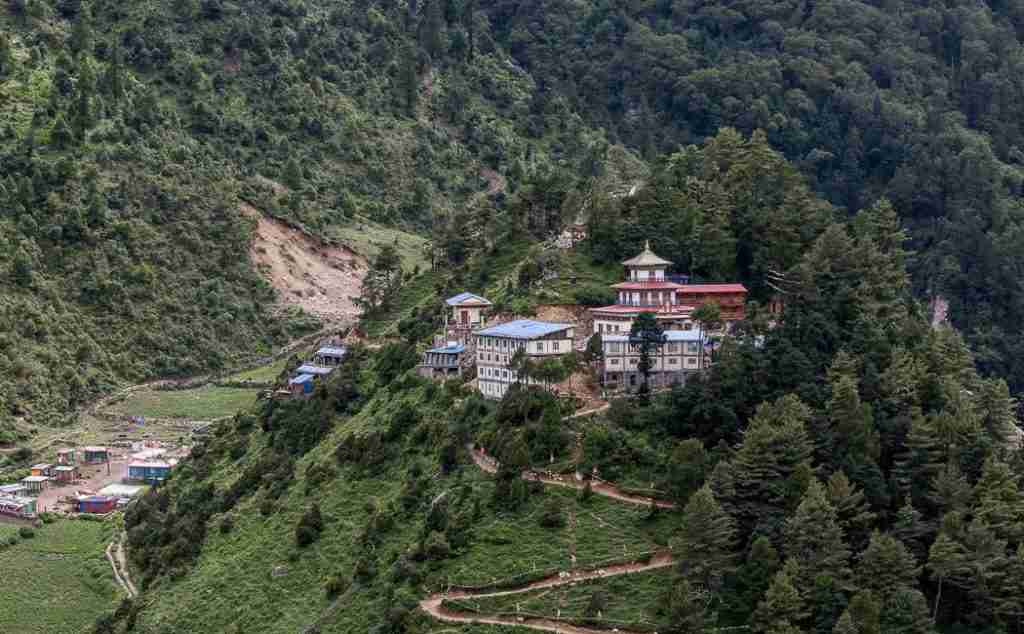
The settlement of the unique tribes of the Tsum and Nubri people is among the exciting facts about Manaslu circuit trek. The two significant ethnicities reside along the Manaslu trails expanding to the Tsum valley. The river of Chikkur separates the settlement of these two tribes.
Nubri
The Nubri community resides in a highly isolated place and is challenging to reach. Their residence in the remote Manaslu Tsum Valley Trek area is a significant reason for this. The 1950s marked the recent opening of the Nubri settlement to tourists.
The Nubris lead relatively isolated lifestyles from the outer world. Their way of life and culture has not altered for hundreds of years. Around 400 years ago, ethnic groups belonging to the Nubri came to the Nubri Valley from Tibet. Around 2000 individuals live in Nubri Valley the current day. They live in one-room houses constructed within the community using stones and wood.
The Nubri people have difficulty growing food because of their high altitude. Animal husbandry is their primary line of work. Yaks, goats, and sheep are cared for by them. They get milk, meat, and skins from these animals. They craft and fully exchange a variety of products for other essentials.
Tsumba
The South Asian People’s affinity group includes the South Asian Buddhist affinity group, which includes the Tsumbas. Only Nepal is home to this ethnic group. Their mother tongue is Tsum. They practice Tibetan Buddhism, a variety of Buddhism only practiced in Tibet and some areas of the Himalayas. This sect of Buddhism is the main religion of the Tsumba people.
As per their folklore, a Beyul, also known as a sacred sanctuary, Guru Rinpoche, inhabited the Tsum valley. At the beginning of the eighth century, he was the one who brought Buddhism to Nepal.
People consider Tsum a sacred location with solid spiritual significance due to Buddhist cultural beliefs and practices upholding the Tsum valley. These values live due to the support of devoted authorities and revered monastic Lamas.
8) The rich bio-diversity and rare wildlife
The Manaslu circuit trail houses the protected Manaslu Conservation Area. The 163 sq. km wide area is popular for housing rare animals and plants. Manaslu Conservation area houses around 33 mammals, 110 species of birds, around three reptiles, and about 2000 species of plants. Among this wildlife also fall rare and endangered animals like the Gray Wolf, Blue Sheep, Langur Monkey, Himalayan Musk deer, etc.
The rare animals of Manaslu are protected by the government. However, the people of the area also take great care of the wildlife. The monks of the monastery in the area’s vicinity prevent the hunting of wild animals. The community spirit helps enhance and improve the Manalsu region’s wildlife.
Along with the wildlife, the trails of Manaslu are also diverse in vegetation. The region has a wide range of hills that differ in elevation. The category of low hill, medium mountain, and high mountain exists in the region. These landforms carry unique wood and come from varied species. There are 19 different types of forests within these landforms. The Ganesh Himal and Sringi hills face the valley basin, which has a diverse ecotone. They have nineteen varieties of woodland, mostly rhododendron and Himalayan blue pine.
9) The climate of the Manaslu region
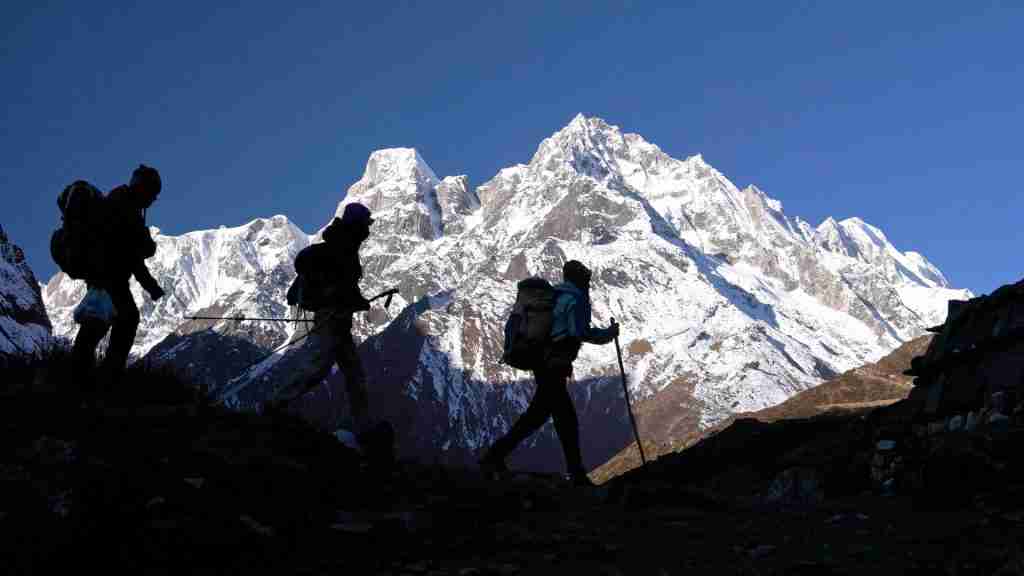
One of the many facts about Manaslu circuit trek you should know is its climate. The temperature of the Manaslu region ranges from -8 degrees Celsius to 30 degrees Celsius.
The Manaslu weather and climate vary based on the time of the year. The summer months in Manaslu are hot like any other place in Nepal. However, the heat varies based on altitude. It means the lower altitude will experience comparatively hotter summers than the higher places. Summer also brings heavy rainfall and landslides. You might experience heavy winds during the monsoon times too.
The winter in the Manaslu trails experiences freezing weather. It brings in an ample amount of snowfall and very cold weather. Chances of snowstorms and road blockages might increase due to snow.
Spring and autumn in Manaslu have comparatively more stable climates than summer and winter. The chances of snowfall and rainfall are less, so the climate is mostly stable. The temperature is not in the extremes and makes up for a good time to trek. Many risks brought by rainfall and snowfall eliminate during these months.
See more on: Best Time to trek Manaslu Circuit
10) The ancient salt trading routes
Last but not least, facts about Manaslu Circuit Trek are that there is a historic salt trade route known as the Tibet-Nepal route. It lies between the Tibetan Plateau and Nepal’s Middle Hills and onward to India. Nepalis and Tibetans used to trade goods through several mountain passes. Back in the day, the hills of Nepal were the cornerstone for rice production. On the other hand, the Tibetan lakes, like Namtso, provided salt. Hence, this established a trade route between these places.
For millennia, this trade practice and route flourished. It gave Tibetan speaking population of Nepal an opportunity for barter. They used grain and other agricultural products of Nepal in return for wool from Tibet. This barter went north of the border and south in Nepal, extending to India.
The trading route went alongside the Budhi Gandaki river. It also was a part of the Great Himalayan trail of Nepal. This means the Manaslu circuit trail was a major part of the trading route. Hence, the Manaslu circuit trails have great significance in the trade history of Nepal, Tibet, and India.
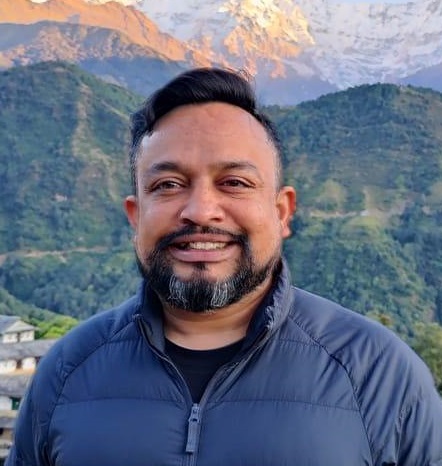
Raj is the co-founder of Mosaic Adventure who have immense knowledge of all the trail throughout Nepal. Working on the trekking industry for more than three decades Raj knows the country like back of his hands. If you need more information or help to plan any trips to Nepal, feel free to get in touch with Raj through his email [email protected] or whatsapp him on +9779851090836.

